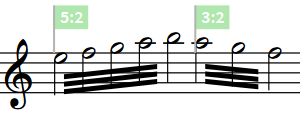Tremolos
Tremolos are thick, slanted lines that cross individual stems or are positioned between multiple stems. They are used to indicate that notes are repeated, either individually or in sequences of multiple notes.
Using tremolo strokes instead of notating each notehead can save horizontal space and make fast passages easier to read.

The number of tremolo strokes indicates both how many times notes are repeated and how fast they are. In measured tremolos, for example, one tremolo stroke on the stem of a quarter note (crotchet) indicates two eighth notes (quavers) are played, whereas three tremolo strokes on the stem of a quarter note indicates eight 32nd notes are played.

|

|
There are different types of tremolos:
- Single-note tremolos
-
Individual notes are repeated. Single-note tremolos are positioned on note stems.

Figure 3. Two-stroke single-note tremolos added to four quarter notes - Multi-note tremolos
-
Multiple notes, usually two, are played in sequence, similar to a trill. However, trills usually indicate a fast alternation between two adjacent notes, such as G and A, whereas multi-note tremolos can be between any notes, limited only by the capabilities of the instrument.
All notes in multi-note tremolos indicate the total duration of the tremolo. For example, two quarter notes joined by a multi-note tremolo both appear as half notes.
Multi-note tremolos are positioned between the stems of two or more notes.

Figure 4. Four quarter notes without tremolos 
Figure 5. Multi-note tremolos input between those quarter notes, in two pairs - Tuplet tremolos
-
Multiple notes in tuplets are repeated in the notated sequence. Tuplet tremolos are positioned between all the notes in the tuplet.

Figure 6. Quarter notes in two different tuplets without tremolos 
Figure 7. Multi-note tuplet tremolos input across those tuplets
Depending on the musical context, tremolos can be either measured or unmeasured. There is no visual difference between measured/unmeasured tremolos, so composers/arrangers often specify how they want tremolos to be played, such as an indication in the front matter of the score or as a text instruction in the score.
- Measured tremolos
-
The number of tremolo strokes corresponds to a precise rhythm in the prevailing tempo and meter.
- Unmeasured tremolos
-
There is no link between the number of strokes and rhythm. Instead, unmeasured tremolos are played as fast as possible, whatever the tempo.
Unmeasured tremolos often use three or more tremolo strokes, and can also be accompanied by a “trem.” text indication.